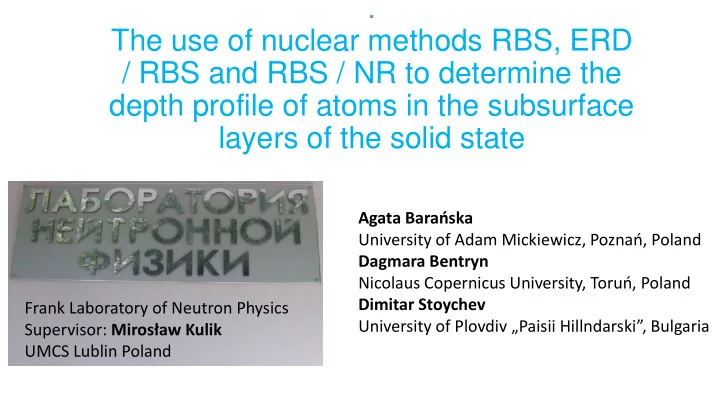

. The use of nuclear methods RBS, ERD / RBS and RBS / NR to determine the depth profile of atoms in the subsurface layers of the solid state Agata Barańska University of Adam Mickiewicz, Poznań, Poland Dagmara Bentryn Nicolaus Copernicus University , Toruń, Poland Dimitar Stoychev Frank Laboratory of Neutron Physics University of Plovdiv „ Paisii Hillndarski ”, Bulgaria Supervisor: Mirosław Kulik UMCS Lublin Poland
Table of contents 1. Physical basics of nuclear methods 2. Experiment and method of the study 2. RBS-Rutherford Backscattering 3. ERD-Elastic Recoil Detection 4. NR-Nuclear Reaction 5. Conclusion
Physical basics of nuclear methods Hans Geiger Ernest Rutherford Series of experiments (Geiger-Marsden)conducted between 1908 and 1913 led to the discovery of nucleus. Ernest Marsden
Experiment and experimental apparatus EG5 – van der Graaf accelerator Experimental apparatus(scheme) 1. Ion beam 2. Magnetic lenses and screen forming ion beam 3. Holder Ion source 4. Sample 5. Screen 6. Detector Dome- collects an electrostatic charge 7. Multichannel analizator 8. Computer
RBS • Elastic collision between particle with the eneregy E o and stationary nucleus, • mirror surface • constant atomic density in layer • Rapid change of the density between two neigbouring layers (assumption) Simple model of scattering process Scheme of elastic collision
Conservation of momenetum Conservation of kineti energy M V M V cos( ) M V cos( ) 2 2 2 1 o 1 1 2 2 M V M V M V 1 0 1 1 2 2 M V sin( ) M V sin( ) 0 2 2 2 1 1 2 2 Kinematical factor Energy of scattered projectile 2 2 2 2 M cos M M sin E kE 1 1 1 1 2 k 1 0 M M 1 2 Yield Y = σ( Ө , E) D Nt dΩ D- total numer of incydent ions Nt – concentration of atoms in the layer σ( Ө , E)- cross-section dΩ - solid angle
0 2 4 6 8 10 2000 simulated simulated experimental experiment [counts] experimental simulated [counts] =60 experimental [counts] simulated [counts] =30 Al Al 2000 1000 In In 0 0 1000 1500 2000 2500 1000 1500 2000 energy [keV] energy [keV] E α = 2028 keV ϴ =170 o C O 6 Al In 4 elements Graph1. The profile depth. 2 0 15 Atoms/cm 2 ] Depth [1*10
simulated Nsurface experimental simulated experimental N surface 2000 Si substrate 30 3000 experimental [counts] Sisurface Si substrate simulated [counts] experimental [counts] simulated [counts] 1500 2000 Si surface E α = 2028 keV 1000 1000 ϴ =170 o 500 0 500 1000 1500 0 energy [keV] 500 1000 1500 2000 Spectrum: Agata Barańska energy [keV] 1250 simulated simulated experimental 3000 experimental 1000 2500 experimental [counts] simulated [counts] Al experimental [counts] simulated [counts] Al 2000 750 Sn 1500 E α = 2028 keV Sn 500 1000 ϴ =170 o 250 500 0 0 500 1000 1500 2000 2500 500 1000 1500 2000 2500 energy [keV] energy [keV] Spectrum: Dimitar Stoychev
sample ERD Detector RBS Detector ERD 2 2 2 2 Simple model of M M cos M sin scattering process 1 1 1 1 2 k M M 1 2
experimental simulated 15000 140 H 120 60 Bi 100 experimental [counts] Energy= 2297[keV] 80 yield [counts] experimental [counts] 10000 o =30 40 60 40 20 simulated 20 experimental 0 2000 2100 2200 2300 2400 2500 5000 energy [keV] 0 400 600 800 Energy [keV] 0 1000 2000 3000 energy [keV] sample St922 15 Concentartion [%] sample St922 H 0,3 Concentartion [%] 10 Bi E He + =2297 keV 0,2 5 E He + =2297 keV 0,1 0 0,0 0 1000 2000 3000 4000 15 [atoms/cm 2 ] Thickness 1x10 0 1000 2000 3000 4000 5000 15 [atoms/cm 2 ] Thickness 1x10
8 simulated sample 223 experimental Concentration [%] 30000 H 6 Yield [counts] 4 sample 223 15000 2 0 0 0 2000 4000 600 800 15 [atoms/cm 2 ] Thickness [1x10 Energy [keV] 100 60 Concentration [%] 80 Si 60 50 Concentration [%] O 60 40 50 sample 223 Concentration [%] 40 30 sample 223 Al 40 20 20 30 10 0 sample 223 6 20 0 0 2000 4000 6000 0 2000 4000 6000 10 15 [atoms/cm 2 ] Concentration [%] Thickness [1x10 N 15 [atoms/cm 2 ] 4 Thickness [1x10 0 sample 223 0 2000 4000 6000 The depth distribution of elements in the MOS structure 2 15 [atoms/cm 2 ] Thickness [1x10 0 Spectrum: Dagmara Bentryn 0 2000 4000 6000 15 [atoms/cm 2 ] Thickness [1x10
500 Hydrogen E He + =2297 keV Experimental Yield [counts] o 400 6000 =135 o O SiO 2 =75 yield [counts] 300 Si SiO 2 4000 200 Si SiO 2 2000 experimental 100 simulated 0 500 1000 1500 0 400 450 500 550 600 650 700 750 Energy [keV] Energy [keV] B 10 concenration [%] 5 Spectrum: Agata Barańska 0 0 2000 4000 15 /cm 2 ] Thickness [atoms 1x10
RBS/NR . Yield depends on: • number of incident particles • atomic density of elements in the target • cross-section • solid angle 2 1 2 2 M cos 1 sin 1 M 2 2 2 Z Z e d 1 2 2 1 d 2 E sin ( ) 2 2 M 1 sin 1 Simple model of M 2 scattering process
sample St404 60 Concentration [%] O 40 Fe Co Ag 20 0 0 100 200 300 400 500 15 [atoms/cm 2 ] Thickness [1x10
Spectra: Dagmara Bentryn O surface 3000 E=3030keV o 30 2000 Si substrate o simulated 170 Si surface Spectrum: Agata Barańska 1000 0 1000 1500 energy (keV)
Conclusions Application of the classical description The ability to identify impurities and their distributions Layer thickness
Thank you for your attention
Recommend
More recommend